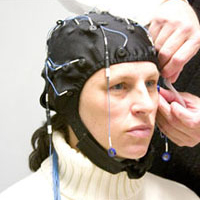Psychology Researchers to Measure Brain Response
 Researchers in the Psychology Department are preparing to conduct experiments to measure the brain's response to certain kinds of stimuli.
Researchers in the Psychology Department are preparing to conduct experiments to measure the brain's response to certain kinds of stimuli.
The tests involve the repeated presentation of a stimulus event that requires a specific behavioral response.
Depending on the experiment, a procedure might be as simple as having a flashing symbol serve as a stimulus that calls for a subject to click a computer mouse as a response. The stimulus also might be the presentation of two words and the response involving a decision about whether the words are semantically related. New instrumentation allows experimenters to observe the activity of the cerebral cortex-the surface of the brain-as a subject responds to stimuli.
Measurement of the brain's electrophysiological response to stimuli, known as event-related potential (ERP), is made possible by NeuroScan equipment, purchased with assistance from a science recapitalization equipment award provided by Carl Strikwerda, the dean of Arts & Sciences.
In an initiative led by Associate Professor Chris Ball, members of the psychology faculty and the neurosciences faculty have developed an ERP lab in the Bell Building. He explained that participants in ERP experiments wear a skullcap studded with electrodes placed to correspond with distinct locations of the cerebral cortex. Actual ERP recording is connected to the presentation of stimulus events, but the electrodes also detect extraneous so-called "noise"--eye movements, for example. Experimenters factor out the noise factor by running multiple tests.
"You can't do it once. You have to do it a couple hundred times," Ball said. "That's the disadvantage of it. You've got to do a lot of trials and get an average."
Ball and other faculty are learning how to use the new ERP equipment and planning specific experiments to be conducted this spring. He will be using the equipment in his research studies of autobiographical memory retrieval and focusing on the role of the frontal cortex for retrieving those personal experiences.
"This equipment will also be used for teaching, particularly in our neuroscience concentration," Ball said. "We have a class called Cognitive Neuroscience, taught by [Assistant] Professor [Jennifer] Stevens and [Assistant] Professor [Joshua] Burk, and I teach an advanced research class in human cognition that will provide undergraduate students at the College with hands-on experience with this cutting-edge technology."
Stevens will further her investigations about the human "potentiated state," a term she uses to describe how the body is always ready to do something and how the mind knows what the body has the ability to do. She describes a paradigm beginning with subjects who are visualizing that they are swinging their arms.
"So in a simple case, they're doing actual arm swings. Then they're just standing at rest and imagining doing 20 arm swings, but then we change their posture," Stevens said. "One of the things I do is just have them standing against the wall. They're still at rest, but they can feel that they're against the wall." The experiment continues with subjects sitting on a small wooden bench with their arms unencumbered, then sitting against the wall, then lying down. The instructions are always the same-imagine swinging your arms. "As the posture gets less and less optimal for doing something like an arm swing, it takes the mind longer to imagine doing so," she said. "It's interesting, because in all of the conditions the body is never doing anything actively, it's always at rest. The question is this: Why would a change in posture translate to an increased time frame for completing an imagined movement?"
The new equipment's ability to pinpoint the area of the brain's response to stimuli will help to reveal the answer. One theory, Stevens said, is that the wall constitutes an interference in the mind's computation of its potentiated state. The other possibility is that the subject first has to take a mental step away from the wall and that this movement into a secondary state accounts for the extra time.
"The ERP will actually show us this, because if you are taking a step away, then essentially you're going to visualize yourself doing it." Stevens said. "Something like visual imagery is always going to activate the occipital lobe in the back of the brain. Whereas, if you're not visualizing taking a step away and there's a motor signal constantly interfering, then you're going to have something like the motor cortex or the premotor cortex activated and showing that delayed response."
 Skip to main content
Skip to main content
